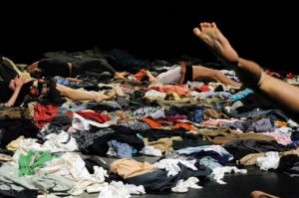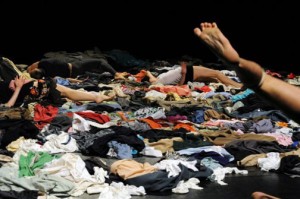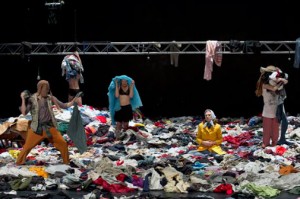
The titel Tauberbach of one of the latest pieces of Les Ballets C de la B and Alain Platel, if translatable at all might be read as deafbach, which includes this misspelling of putting two words (deaf +Bach) together, which usually are not written that way. Tauberbach refers to the work of the polish artist Artur Zmijewski’s recordings of what he called Deaf Bach. Choir works of Bach sung by deaf or nearly deaf people.
Another source for this piece is the film ‘Estamira’ by Marcos Prado about a schizophrenic woman, who lived for more than 20 years on a big landfill near Rio de Janeiro. ‘Estamira’ gives the template for the imposing presence of the Dutch actress Elsie de Brauw. Talking, screaming, singing, or just making noises she embodies especially in the beginning the role of theater in this hybrid piece that gets taken over by the physics of movement/dance.

In the artist talk, which followed the performance at the HAU in Berlin, Elsie de Brauw stated that it is this becoming of physicality, a getting out of your head’ that she enjoyed more than feared when she described the process and scenes she is put through in her character in the encounter with the dancers. It is almost a rough scene in which she gets stopped in her speech and is torn, thrown, carried around, as well as covered with clothes by her fellows on stage. The audience almost can feel how she gets introduced to that other way of being, a being that senses and is sensed, that is wild, but never brutal in its becoming sensual. It is an exploration into non-verbal behavior of bodily moves and sounds – a ‘becoming body’ as the choreographer and dancer Lisi Estaras defines it, who herself delves deeply into moments of exploring lust and sexuality together with Romeu Runa.
The piece is marked by the constant attempt to find movements of the subconscious, to define movement out of itself, as movement that just develops because of moving. It is played out through the very differently defined and shaped bodies of the various dancers each respected in their own way. Most impressively again is especially Elsie de Brauw’s courage and neglect of vanity as she shows her body’s expressions that speak in a certain contrast to the bodily movement trained ones. If there are weak points in this remarkable evening it is eventually the reference to known moves and figures, and some lengths in other scenes like in the nevertheless spontaneously applauded movement/sound film-like transitions of Ross McCormack.
To put the impact of this show into words is not that easy, it indeed tackles something else than what might be defined as everyday intellectual needs, but that cannot be addressed as being just emotional. The best way to describe it might be to call it affective as far as the affect leads to an e/motion that triggers sensations in an uncommon way. It affects the viewer, and may it be just as has been brought up by one visitor, who was cited by Annemie Vanackere, that “it makes me horny to watch this piece, while I can’t say that it is pornographic at allâ€. This in fact is a great statement in times of an omnipresent discussion on the theme. It might hint, that what really affects us – if we dare let it get to us – is something beyond the profusion which we surround us with and from which we build our landfills.
Tauberbach by Les Ballets C de la B and Alain Platel at the Münchner Kammerspiele / youtube
Concept/ direction: Alain Platel
Creation/ performance: Bérengère Bodin, Elie Tass, Elsie de Brauw, Lisi Estaras, Romeu Runa, Ross McCormack
And what about Bach? “Let’s fuck on Bachâ€, was another point A.Platel wanted to make, as he stated in the discussion. Not only that he wanted to have Bach heard in a different way by the usage of the above stated material of deaf musicians, but he also wanted Bach’s music to be noticed as deeply human affective that touches our sentiments. To show the famous composer not only as the mathematical genius of music as which he commonly is regarded, but as someone who himself anchors in the wide range of human sentiments. Platel’s theme that is to delve deeply into the human, to not shy away from what does not belong to standards of fitting and beauty, is once again extensively played out with humor and tender respect for the other form of expression – quite as I recall it from his 2010 piece Gardenia.
>>> watch video on vimeo
A nice German review and summary can be found at BR2: “Ein einziges großes Werden, das hier tänzerisch vonstatten geht” und das zu Musik von Bach, wie sie sich taube Menschen vorstellen.
